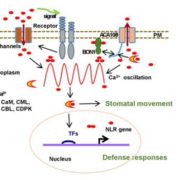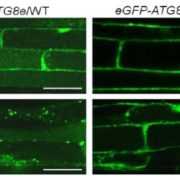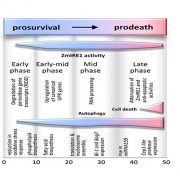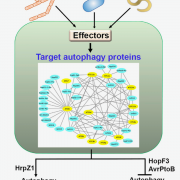Selective autophagy of THOUSAND GRAIN WEIGHT 6 protein
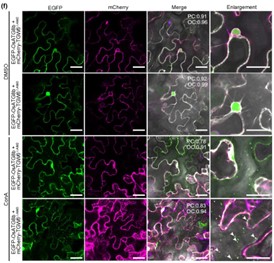 Rice is a globally important crop, therefore increasing yield without compromising quality is of much interest. A reduction in the amount of the TGW6 (THOUSAND-GRAIN WEIGHT 6) protein is associated with improved grain yield and quality in rice. However, we do not fully understand how TGW6 protein levels are controlled in developing rice grains. Here, bimolecular complementation and split luciferase assays were used to show that TGW6 interacts with the autophagosome component ATG8b in planta. This interaction was dependent on a motif called AIM2 in the TGW6 protein, as when the AIM2 motif was mutated the TGW6-ATG8b interaction was abolished. To test whether the interaction leads to autophagosome-induced degradation of TGW6, the authors transiently expressed fluorescent-tagged versions of TGW6, either with or without the AIM2 mutation, in Nicotiana benthamiana. Autophagic bodies were stabilized by application of Concanamycin A, allowing TGW6 puncta in autophagic bodies in the vacuole to be quantified. The authors found less TGW6 puncta when AIM2 was mutated, suggesting the TGW6-ATG8b interaction is needed for selective autophagy of TGW6. Hence, this study has unveiled a new mechanism by which TWG6 protein levels are controlled in plants and this knowledge could be used to further increase grain yield and quality in rice. (Summary by Rose McNelly @Rose_McN) New Phytol. 10.1111/nph.19271
Rice is a globally important crop, therefore increasing yield without compromising quality is of much interest. A reduction in the amount of the TGW6 (THOUSAND-GRAIN WEIGHT 6) protein is associated with improved grain yield and quality in rice. However, we do not fully understand how TGW6 protein levels are controlled in developing rice grains. Here, bimolecular complementation and split luciferase assays were used to show that TGW6 interacts with the autophagosome component ATG8b in planta. This interaction was dependent on a motif called AIM2 in the TGW6 protein, as when the AIM2 motif was mutated the TGW6-ATG8b interaction was abolished. To test whether the interaction leads to autophagosome-induced degradation of TGW6, the authors transiently expressed fluorescent-tagged versions of TGW6, either with or without the AIM2 mutation, in Nicotiana benthamiana. Autophagic bodies were stabilized by application of Concanamycin A, allowing TGW6 puncta in autophagic bodies in the vacuole to be quantified. The authors found less TGW6 puncta when AIM2 was mutated, suggesting the TGW6-ATG8b interaction is needed for selective autophagy of TGW6. Hence, this study has unveiled a new mechanism by which TWG6 protein levels are controlled in plants and this knowledge could be used to further increase grain yield and quality in rice. (Summary by Rose McNelly @Rose_McN) New Phytol. 10.1111/nph.19271




